cross-channel marketing attribution: Boost ROI with insights
- Chase McGowan

- 4 days ago
- 14 min read
Ever stare at your marketing reports and feel like the numbers just don't add up? You're not alone. Countless businesses pour money into high agency fees only to get muddy reports, leaving them to guess which marketing efforts are actually driving sales.
The answer is cross-channel marketing attribution. It’s simply a way of giving credit where credit is due—assigning value to every single touchpoint a customer interacts with on their way to making a purchase. It gives you the full, honest picture of your performance.
Why Your Agency Gets Attribution Wrong
If you’ve ever felt like your marketing reports are telling a confusing story, you’ve hit the wall of flawed attribution. Many brands partner with big, bloated agencies expecting sharp, sophisticated insights. What they get instead are simplistic reports that give 100% of the credit for a sale to the very last click a customer made—which is often just a branded search ad.
That's like trying to understand an entire football game by only watching the final goal. You completely miss the skillful passes, the solid defense, and all the strategic plays that made that goal possible. This "last-click" model is the go-to for most oversized agencies because it's easy to report, not because it’s right. They run a factory line, slapping the same generic template on every client, completely ignoring the unique journey your customers take.
The Agency Blind Spot
This siloed view creates huge problems. When an agency only gives credit to that final touchpoint, they always overvalue bottom-of-the-funnel channels and completely undervalue the crucial work that social media, display ads, and organic content do to build awareness. This leads directly to bad decisions and wasted ad spend.
This graphic breaks down the damaging chain reaction that starts with this narrow, agency-style perspective.
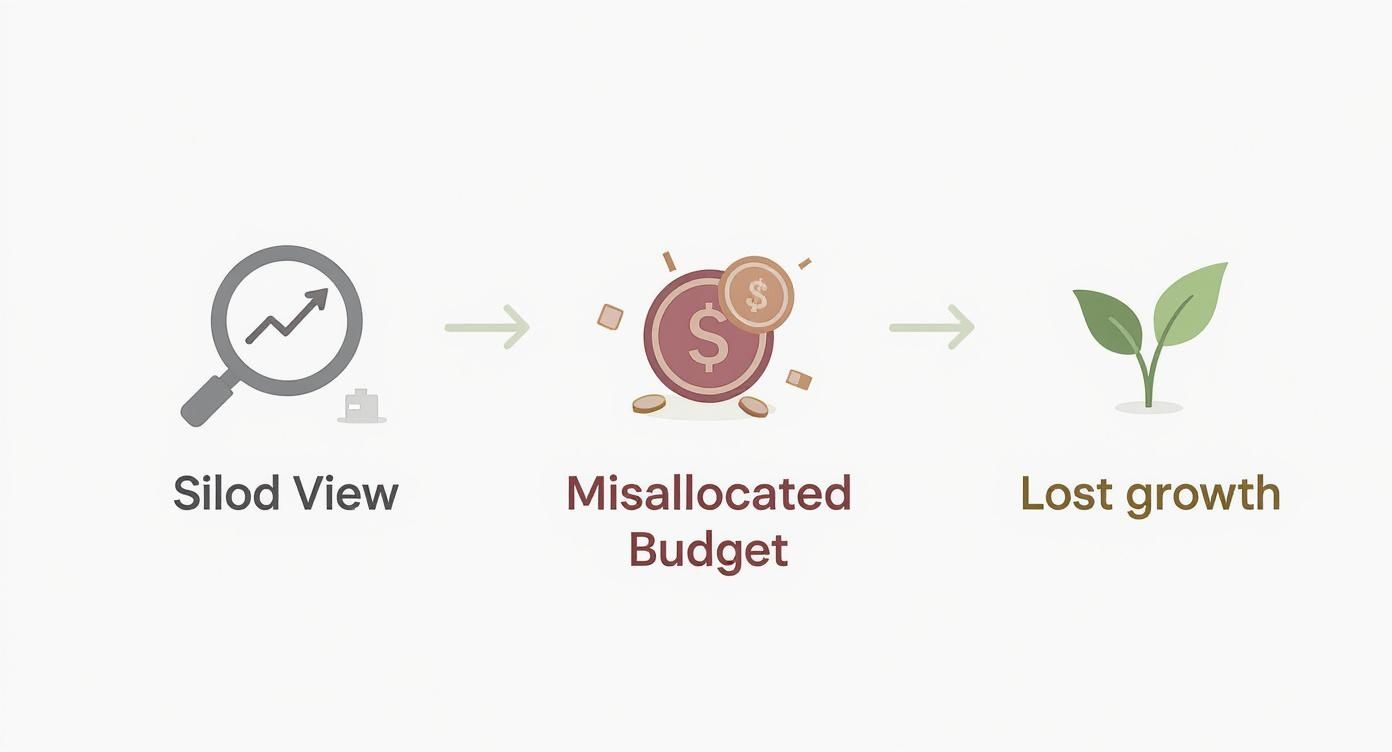
As you can see, a flawed view of performance is a direct line to misallocating your budget, which ultimately stunts your business's growth. You end up pulling funds from the very channels that are quietly building your audience, all because their contribution wasn't captured in a basic, lazy report.
The Specialist Advantage
A dedicated Google Ads consultant, on the other hand, digs deeper. My focus isn’t on churning out templated reports; it's on understanding the complete story of your customer's path to purchase. A real expert's approach to cross-channel marketing attribution involves:
Holistic Analysis: Looking at every interaction—from the first blog post they read to the final ad they clicked—to see how all your channels work together as a team.
Custom Strategy: Building a measurement plan that actually reflects your specific sales cycle, not some one-size-fits-all model.
Transparent Insights: Translating complex data into clear, actionable advice that stops you from making expensive mistakes.
The core issue is that outdated attribution models lead to misallocated budgets and missed opportunities. A focused specialist is equipped to prevent these costly errors by providing a clear, comprehensive view of what's actually working.
Relying on an agency's simplistic model is a gamble you can't afford. To see how a consultant's approach stacks up against agency hype, check out our detailed guide on attribution modeling. It’s time to stop guessing and start making decisions based on the full story.
The Hidden Costs of Flawed Attribution Models

If your marketing reports feel like they’re telling half the story, it’s probably because they are. Most reporting is built on a shaky foundation: simplistic attribution models that create dangerous blind spots and end up costing you real money.
This problem gets even worse with big, impersonal agencies. They often default to these easy models because they spit out clean, simple reports that look good in a presentation—even when those reports are hiding the truth about what’s actually working.
A classic example? An overpriced agency shows you a beautiful dashboard highlighting Branded Search as your top-performing channel. What they conveniently leave out is the months of social media engagement and blog content that made people search for your brand in the first place. Their goal is to show a simple, upward-trending line on a graph, not to do the hard work of untangling your true customer journey.
Let's pull back the curtain on the models they lean on and expose the hidden costs.
Single-Touch Models: The Agency Favorites
The most common—and most misleading—models are the ones that give 100% of the credit to a single touchpoint. Bloated agencies absolutely love these because they’re incredibly easy to set up and explain to clients.
First-Click Attribution: This model gives all the credit to the very first time a customer ever interacted with your brand. While it can offer a glimpse into initial awareness, it completely ignores every single step that followed to nurture that lead and actually close the sale.
Last-Click Attribution: This is the default setting for a reason—it’s the easiest. It assigns all the credit to the final click right before a conversion. This model consistently makes channels like Branded Search and Direct traffic look like heroes, while giving zero credit to the top-of-funnel activities that introduced the customer to you.
Relying on these is like giving a bonus only to the salesperson who got the final signature on a massive deal, while completely ignoring the marketers, engineers, and support staff who made it all possible.
Flawed Multi-Touch Models
Slightly more sophisticated, multi-touch models try to spread the credit around, but their simplistic formulas still don't reflect reality. They might look better on paper, but they often just create a different set of distortions.
The real problem is that these simplistic models create a false sense of security. They produce neat reports that make it seem like performance is under control, while your budget is actively being wasted on misunderstood channels.
For instance, a Linear model gives equal credit to every single touchpoint. That means a click on a high-intent Google Search Ad is valued exactly the same as a passive view of a Facebook post from three weeks ago. It sounds fair, but it’s not. Not all interactions carry the same weight.
A Time-Decay model gives more credit to touchpoints closer to the sale. This is a step in the right direction, but it can still undervalue those critical, early-stage awareness campaigns that happened weeks or even months before the purchase, just because they're "old."
Comparing Common Attribution Models And Their Business Impact
This table breaks down the usual suspects. I’ll show you how each model assigns credit and, more importantly, reveal the blind spot it creates—a blind spot that generalist agencies often exploit.
Attribution Model | How It Works | Common Business Blind Spot |
|---|---|---|
First-Click | 100% credit to the first touchpoint. | Devalues everything that happens after initial awareness. You might cut budget on channels that are excellent at closing deals. |
Last-Click | 100% credit to the final touchpoint. | Grossly overvalues Branded Search and ignores awareness channels. You risk underfunding the marketing that builds your brand. |
Linear | Equal credit to all touchpoints. | Fails to distinguish high-impact actions from low-impact ones, treating all interactions as equally important. |
Time-Decay | More credit to recent touchpoints. | Underestimates the long-term impact of top-of-funnel marketing that introduces your brand months before a sale. |
In the end, all these models fail to capture one simple truth: the modern customer journey is a mess. People hop between their phone and laptop, see an ad on Instagram, read a blog post, and then type your name into Google.
Unlike the old-school models, true cross-channel marketing attribution is about assigning the right amount of credit to every relevant touchpoint along that messy path. Getting this right isn't just an academic exercise—it has a huge business impact. Companies that nail multi-channel attribution can see efficiency gains of 15–30% in their marketing spend.
The real danger of flawed models is the chain reaction of bad decisions they trigger. They’ll lead you to slash the budget for a social media campaign that’s actually your main source of new leads, all because a last-click report showed it had zero direct conversions. An expert doesn't rely on these generic templates; they build a reporting structure based on reality, not convenience.
Solid data always starts with a solid foundation. You can learn more by reading our guide to fix your Google Ads conversion tracking.
Unlocking Growth with a Custom Attribution Strategy
After seeing the dangerous blind spots that simplistic attribution models create, it becomes crystal clear. That generic agency template isn't just lazy—it's actively costing you money. The answer isn't to find a slightly better pre-packaged model. It's to build a custom attribution strategy that actually mirrors how your unique customers behave.
This is the fundamental difference between hiring an overpriced, bloated agency and partnering with a dedicated Google Ads consultant. An agency gives you a cookie-cutter report built for their own convenience. A specialist sits down with you to understand your sales cycle, map your customer journey, and build a measurement framework that reflects reality.
Instead of just defaulting to last-click, a true expert brings more powerful tools to the table—tools designed for accuracy. This is where a real partnership leaves an impersonal vendor relationship in the dust.
Moving Beyond Simple Models to Data-Driven Attribution
One of the most powerful tools in a specialist's arsenal is Data-Driven Attribution (DDA), available right within Google Ads. Unlike those simple models that rely on fixed rules, DDA uses machine learning to dig into your specific account data. It analyzes the paths of customers who convert and compares them to the paths of those who don't.
By spotting patterns across thousands of touchpoints, it assigns conversion credit based on how much each interaction actually contributed to the sale. This isn't a guess; it's a statistical calculation based on your own performance data.
But DDA isn't a magic "on" switch.
Data-Driven Attribution is an incredibly powerful tool, but its accuracy depends entirely on the quality of the data it receives. A flawed setup will only lead to flawed conclusions, faster. This is where specialized expertise becomes non-negotiable.
An agency might flip on DDA and call it a day, but a consultant ensures the foundation is solid. That means meticulously verifying conversion tracking, making sure data flows cleanly from all your channels, and confirming the algorithm has enough clean data to make intelligent decisions. It’s the difference between a chef handing you a recipe and a chef cooking you a world-class meal.
The Power of a Strategic Partnership in Action
Let’s look at a real-world example. An e-commerce brand selling high-end outdoor gear was stuck in a rut with their agency. Their reports showed that 90% of their conversions came from Branded Search and Direct traffic. Based on this last-click data, the agency told them to slash their budget for top-of-funnel social media and display ads because they showed "zero ROI."
After they switched to a dedicated consultant, we did a deep dive. We rebuilt their tracking from the ground up and implemented a custom attribution strategy centered on Google's DDA model.
The results were dramatic:
Hidden Value Uncovered: The new model revealed that their "zero ROI" social media campaigns were actually responsible for introducing 40% of all new customers to the brand.
Assisted Conversions: We found that for every direct sale from a branded ad, there were three "assists" from earlier touchpoints, like a blog post or a video ad.
Smarter Budget Allocation: Instead of cutting the social budget, we confidently doubled down on the top-performing awareness campaigns. This led to a 35% increase in qualified leads within the first quarter.
This kind of shift was only possible because we moved from an impersonal vendor relationship to a true strategic partnership. We weren't just reporting numbers; we were building a system to understand what those numbers truly meant for the business.
This level of detail is critical. The rise of cross-channel marketing has led to huge increases in both engagement and revenue for brands that get it right. Data shows that cross-channel strategies generate 166% more engagement than single-channel approaches. Furthermore, businesses running these campaigns report 24% higher conversion rates and 23% higher revenue compared to those with siloed strategies. This proves why attribution has to move beyond basic models to more advanced techniques that properly credit each contributing touchpoint. You can find more details about how to win with a smarter cross-channel strategy on youappi.com.
Ultimately, a custom strategy built by an expert doesn't just give you more accurate reports. It unlocks growth by giving you the confidence to invest in the channels that are truly building your business—even if they aren't the ones taking the final bow.
Building Your Cross-Channel Attribution Framework

Moving from theory to practice is where most companies—and frankly, most agencies—fall flat. Building a solid cross-channel marketing attribution framework isn’t just about picking a model off the shelf. It’s about getting your hands dirty with meticulous technical work.
This is where the gap between a high-volume agency and a dedicated specialist becomes painfully obvious.
An agency might sell you on a fancy-sounding model, but their junior account managers often don't have the deep, hands-on experience to build the clean data foundation it needs to actually work. The result? You get garbage-in, garbage-out insights from a flawed system.
Let’s walk through the right way to build a framework, and I'll point out the common pitfalls that only a real specialist knows how to sidestep.
H3: Unifying Your Conversion Tracking
The absolute bedrock of any attribution setup is unified conversion tracking. Every single platform—Google Ads, Google Analytics, your social channels—must measure the exact same actions in the exact same way.
It sounds simple, right? But this is the #1 reason most attribution systems fail.
Big, impersonal agencies often manage channels in silos. The social media team has their pixel, the PPC team has their tags, and no one is talking to each other. This creates massive data discrepancies, making any real cross-channel analysis completely impossible.
An expert centralizes this entire process. We establish a single source of truth, typically using a tool like Google Tag Manager to deploy and manage every tracking tag from one central hub. This guarantees that a "Lead" in your Google Ads account is identical to a "Lead" in your Meta Ads account and your GA4 property.
H3: Ensuring a Clean Data Flow
Once tracking is unified, the next step is making sure that data flows cleanly and consistently. This requires a level of detail-oriented work that gets glossed over in a busy agency setting.
Key actions here include:
Consistent Naming Conventions: We need a strict, logical system for naming everything—campaigns, ad groups, sources, and especially UTM parameters. Inconsistent tags like "facebook_cpc" and "FB-Paid" for the same traffic source pollute your data and completely confuse attribution models.
Cross-Domain Tracking: If your customer journey ever crosses from one domain to another (like a subdomain for checkout), you must have cross-domain tracking set up perfectly. This is a classic failure point that creates gaps and breaks the user's path in your analytics.
Excluding Internal Traffic: You have to filter out traffic from your own team, your agency, and any developers. Failing to do this means internal activity will absolutely skew your conversion data and throw off your reporting.
These little details aren't optional; they're critical. A single misconfigured tag can torpedo your entire model and lead to you throwing budget down the drain. An expert’s value is in this obsessive, hands-on execution.
H3: Integrating CRM Data for a Complete Picture
For most B2B or high-ticket businesses, the journey doesn't stop at a form submission. It moves offline into your CRM, where a lead becomes an opportunity and, eventually, a sale. To measure true ROI, you have to connect your marketing spend to actual revenue.
An attribution framework that only tracks online leads is flying half-blind. By integrating CRM data, you can trace actual sales revenue all the way back to the marketing touchpoints that started the conversation, revealing the true profit drivers in your campaigns.
This is a more advanced step where specialized expertise is essential. It involves piping offline conversion data from your CRM back into platforms like Google Ads. This lets your attribution model see not just which campaigns are generating leads, but which ones are generating your most valuable customers.
Bloated agencies often skip this because it's technically complex and requires tight coordination between teams. A dedicated consultant knows this is non-negotiable for making smart budget decisions. To get this right, you need to understand all the different approaches, and this multi-channel attribution models playbook offers a great step-by-step guide.
At the end of the day, building this framework is less about the tools you have and more about the flawless, detail-obsessed execution required to make them work.
The Tools and Metrics That Reveal the Full Story
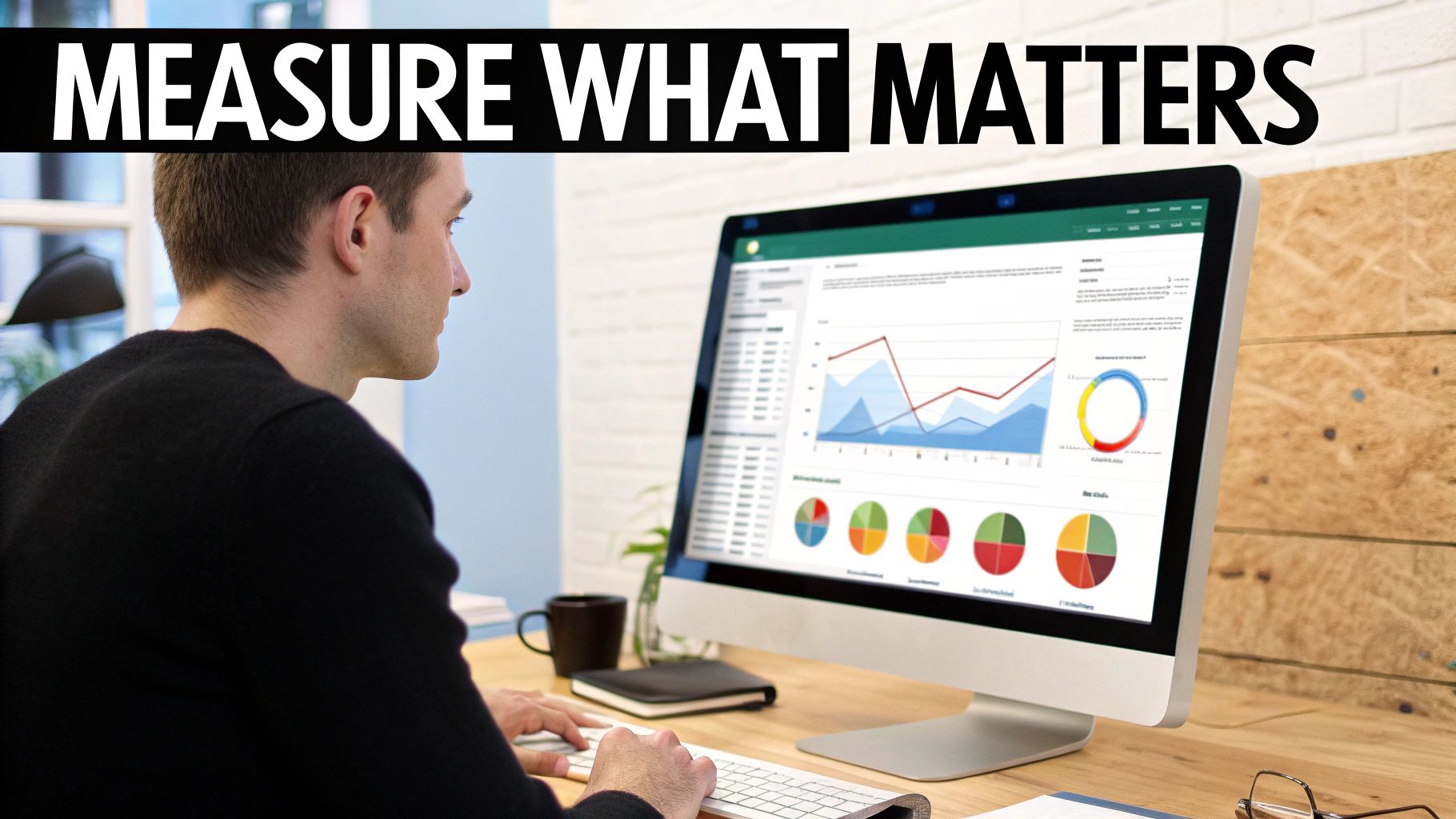
Any cross-channel marketing attribution framework, no matter how sophisticated, is useless without the right tools and a ruthless focus on the right metrics. This is where a seasoned consultant's approach veers sharply from a bloated agency's.
An agency will likely hand you a standard dashboard loaded with vanity metrics—clicks, impressions, maybe a top-line ROAS if you’re lucky. They treat their tools like simple reporting machines.
But a specialist treats a tool like Google Analytics 4 (GA4) as a strategic instrument. We’re not just glancing at surface-level reports; we're diving deep into the attribution path reporting to piece together the complex story of how all your channels work together. It’s not about just seeing the numbers; it’s about building a cohesive narrative around performance that a junior agency account manager would never have the time or training to uncover.
Beyond ROAS to Business Growth Metrics
Return on Ad Spend (ROAS) is an important metric, sure, but it only tells you a fraction of the story. A true expert focuses on the numbers tied directly to your business's financial health and long-term profitability. This means moving way beyond campaign-level data to answer much bigger questions.
Customer Acquisition Cost (CAC) vs. Lifetime Value (LTV): Is it worth paying $100 to acquire a new customer? An agency might say no if the first purchase is only $50. But a consultant digs deeper, looking at LTV and discovering that customer is actually worth $500 over their lifetime. Suddenly, that $100 CAC looks incredibly profitable.
Assisted Conversions: This is the kryptonite of lazy, last-click reporting. It reveals how many times a channel contributed to a sale without getting the final credit. An expert uses this data to protect and scale those crucial top-of-funnel campaigns that agencies often mistakenly cut.
Getting granular by understanding the difference between ROI vs ROAS is essential for precision. This nuanced view is the hallmark of a specialist's approach. You can explore this further in our [consultant's guide to ad performance metrics](https://www.cometogether.media/single-post/a-consultant-s-guide-to-ad-performance-metrics).
The Consultant's Interpretation
The real value isn’t in the tools themselves. It’s in the expert interpretation of the data they provide. While an agency account manager is busy juggling dozens of clients with templated reports, a dedicated consultant is digging into the why behind the numbers.
A consultant uses data to tell a story. We connect the dots between an early social media interaction, a mid-funnel content download, and a final branded search to recommend strategic budget shifts that fuel genuine growth, not just vanity metrics.
This is more critical than ever. Modern consumers don’t live on a single platform. With over 72% of consumers preferring to engage with brands across multiple channels, a siloed view is a recipe for failure.
The proof is in the numbers. Brands that implement smart cross-channel strategies see an 89% customer retention rate, completely dwarfing the 33% for those stuck in a single-channel approach. The financial impact is just as clear; customers who engage across multiple touchpoints spend 30% more.
This is the expert advantage: transforming raw data into a strategic roadmap that an impersonal agency would simply never have the time or specialized skill to build.
Your Questions, Answered
If you’re wondering about cross-channel marketing attribution, you’re in the right place. These are a few of the most common questions I hear from business owners who are tired of generic agency reports and ready for real clarity.
How Can I Tell If My Current Attribution Model Is Wrong?
Here’s a massive red flag: your reports give nearly all the credit for conversions to just one or two channels, like Branded Search or Direct traffic. This almost always means a last-click model is at play, completely ignoring all the hard work your awareness and consideration campaigns are doing.
Think about it. If you're putting money into social media or display ads but they’re showing zero attributable revenue, your model isn’t just a little off—it’s broken. An expert audit can uncover how these “non-converting” channels actually assist conversions, showing you their hidden value before you make the mistake of cutting a budget that’s actually driving growth.
Can't I Just Set Up Cross-Channel Attribution Myself in Google Analytics?
While Google Analytics 4 (GA4) has some powerful data-driven attribution models, the tool is only as smart as the data you feed it. Getting it right is a serious undertaking. It requires meticulous cross-domain tracking, absolutely consistent event naming conventions, and, often, the integration of your offline data.
The most common pitfall I see is "dirty data" flowing from an imperfect setup. This leads to flawed insights, and you end up making bad decisions based on bad information. A specialist ensures your data foundation is rock-solid, so you can actually trust the insights GA4 gives you and avoid the classic "garbage in, garbage out" trap.
Why Shouldn't I Just Trust the Agency I'm Already Paying?
Let's be blunt. Many large agencies are juggling dozens of clients, so they often default to simplified, easy-to-report models to save time. Their incentive is to show you simple, positive-looking numbers from last-click channels, not to do the complex, time-consuming work of mapping the true customer journey.
They might not have the specialized expertise or, frankly, the billable hours to build a custom attribution model that truly fits your business. An independent expert's success is tied directly to your ROI. Our incentive is aligned with uncovering the deepest, most accurate insights—not just churning out another standard monthly report.
This focus on your bottom line is the real difference. A specialist is invested in your actual growth, not just in delivering a sleek but misleading dashboard. It's about a partnership built on tangible results, not a vendor relationship built on convenience.
Ready to stop guessing and start seeing the full story behind your ad spend? Come Together Media LLC replaces agency guesswork with expert-led, data-driven strategy. Let’s build a custom attribution framework that reveals your true ROI and unlocks new growth opportunities.





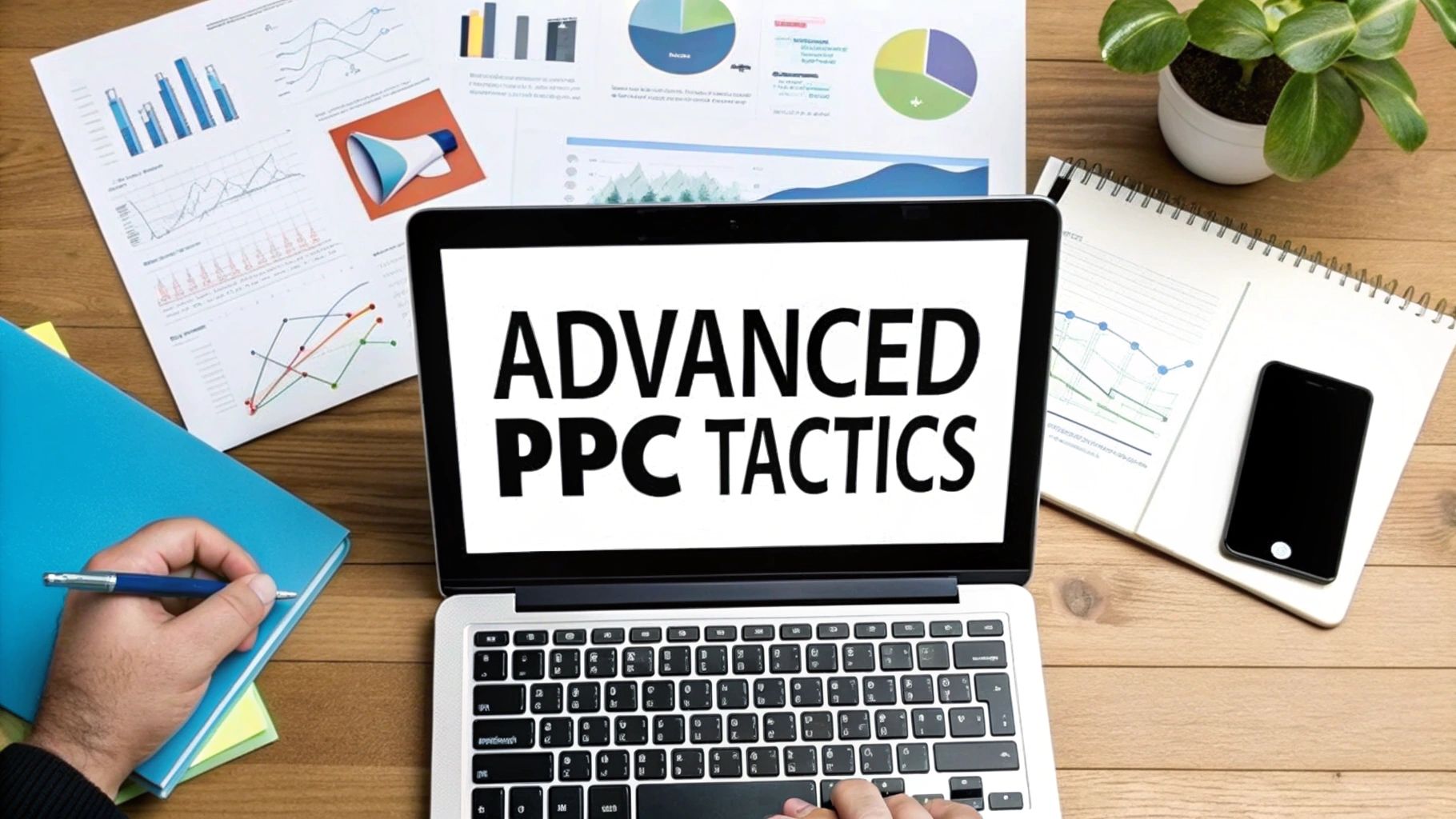
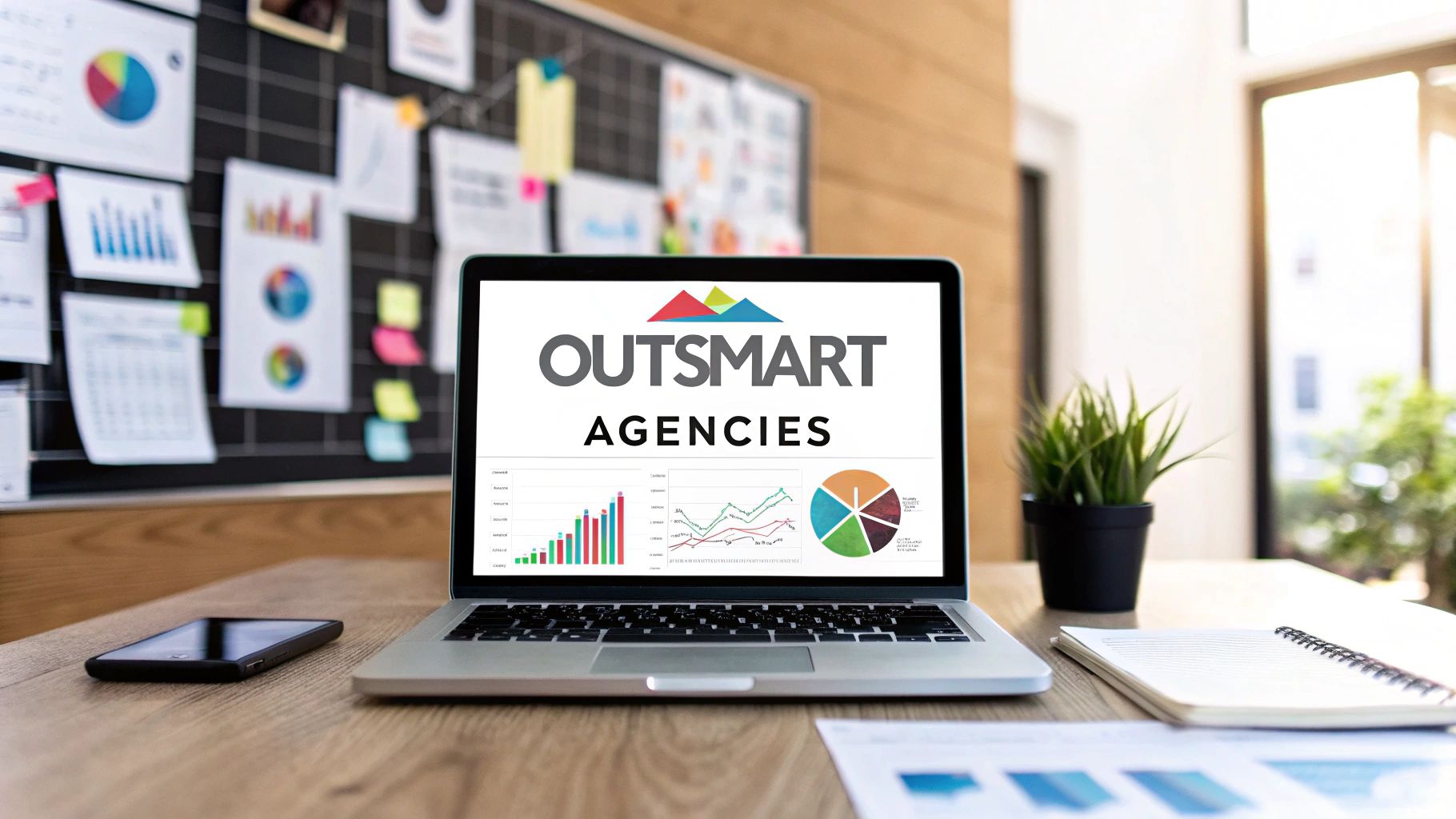

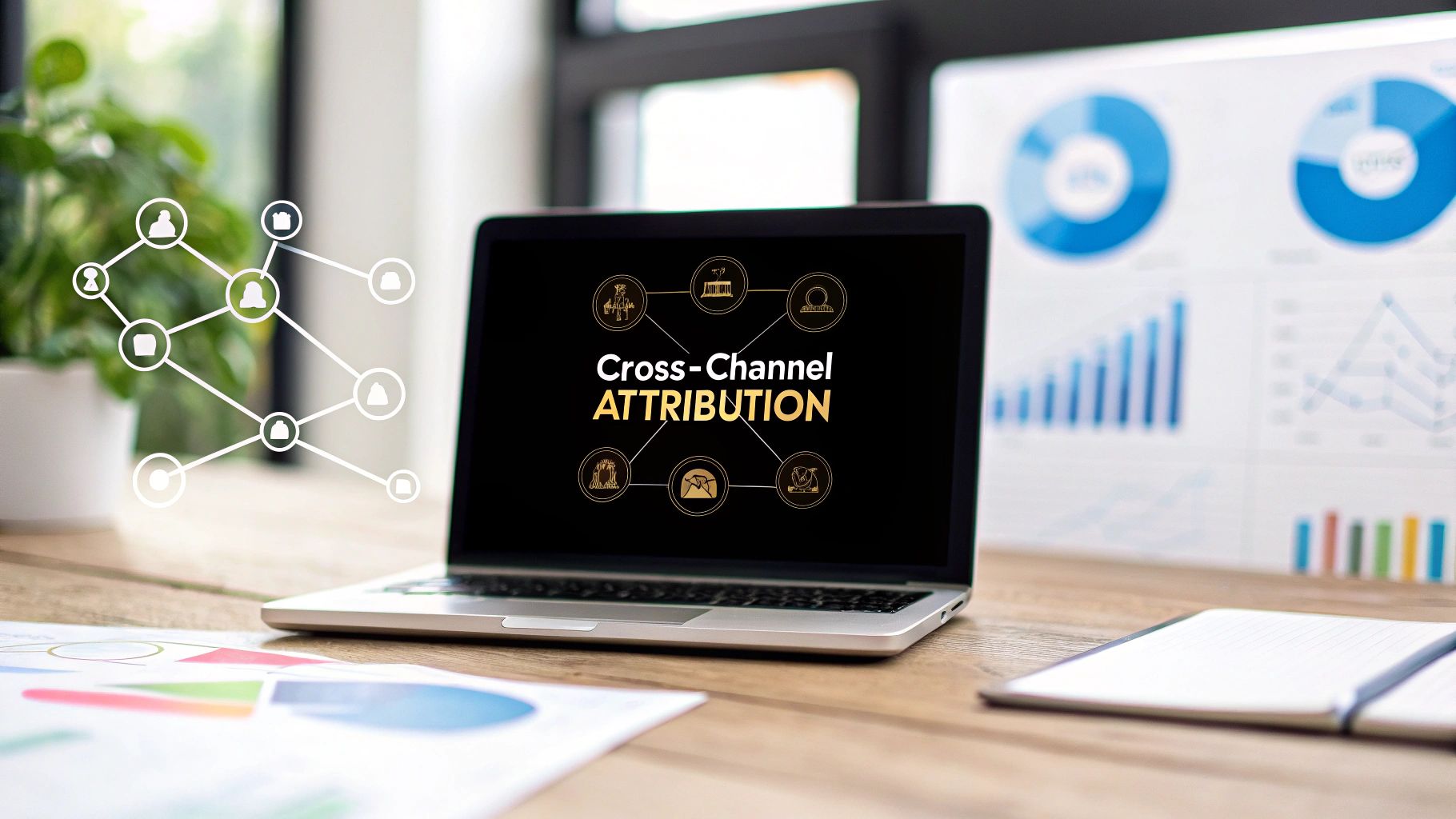





Comments